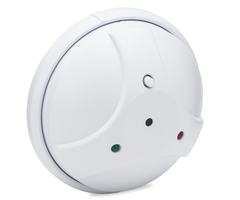Where Should I Install My 2GIG GB1-345 Glass Break Detector?
You should install your 2GIG GB1-345 glass break detector near a glass window or a protective glass casing. The device should have a direct line of sight to the glass. The 2GIG GB1 should also not be placed directly on the glass itself, as it may become damaged if the glass is ever broken.

The 2GIG GB1-345 glass break detector works by listening for the sound of breaking glass and should be mounted within 15 feet of the glass to be protected. In order for the device to activate, it must hear both the "thud" of an object striking against glass and the "shattering" of glass itself. It includes a built-in microphone that actively listens for this type of sound. With this in mind, it is best to place the 2GIG GB1 directly across from, or adjacent to, the glass that you want to monitor, with no obstacles or other objects in the way.
Since you want the 2GIG GB1 to be as close to the glass as possible, you might initially think that it would be a good idea to place the device directly on the glass. However, this is not recommended, as the device might become damaged if the glass is broken. Instead, it is perfectly fine to place the GB1 near the glass where it will still be able to detect the sound of breakages.
Choosing a poor location for the GB1 might prevent the device from functioning properly. If the device is placed too far from the glass, then the sound waves of the glass breaking might not reach the microphone in the GB1, and the device would fail to activate. Likewise, if you have many large objects between the GB1 and the glass, then the large objects might block the sound waves and prevent them from reaching the GB1. Therefore, the best place for a GB1 is near the glass with a direct line of sight to the glass.
Glass Type and Thickness:
The minimum size and shape for all glass types is 11 x 11 inches (28 x 28 cm) square. Glass must be framed in the wall of the room, or mounted in a 36 inch (91 cm) barrier.
|
Glass Type |
Minimum |
Maximum |
|---|---|---|
|
Plate |
⅛ inch (3.2 mm) |
¼ inch (6.4 mm) |
|
Tempered |
⅛ inch (3.2 mm) |
¼ inch (6.4 mm) |
|
Sealed Insulating✝ |
⅛ inch (3.2 mm) |
¼ inch (6.4 mm) |
|
✝Sealed Insulating glass types are protected only if all plates of glass are broken |
||
If you are ever not sure about the placement of your glass break, you can always test the device to make sure that it is working properly. We recommend using a glass break simulator, such as the Honeywell FG701 to do this. It is recommended that you test the GB1 by using the glass break detector in different locations in order to ensure that breaking glass from any given direction will set off the device.
Did you find this answer useful?
We offer alarm monitoring as low as $10 / month
Click Here to Learn More- Answered
